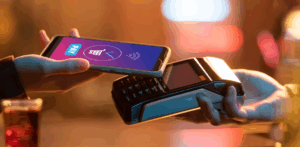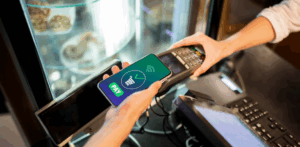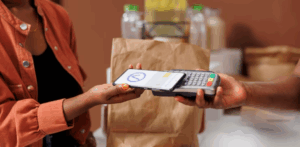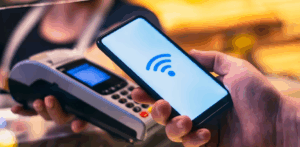
By Yoshie Jenson May 29, 2025

The days of swiping cards or paying in cash are rapidly coming to an end. Contactless payments are replacing them with faster, cleaner and more secure ways to pay.
Driving this revolution is NFC (Near Field Communications). This technology allows devices to transmit information wirelessly when they are a few centimeters apart like tapping your phone or card at one of those terminals.
The pandemic fast-tracked this transition. Consumers made safety a priority and businesses raced to install touch-free payment systems. This payment system is now not merely convenient but essential. Let’s learn more about it and why companies need to accept this and how to start payment processing with contactless payment options.
What Are Contactless Payments?
With contactless payments, customers are able to tap their card or smartphone on a payment terminal to pay in a much less time-consuming way than swiping, inserting or signing. The transactions are made using a card with near-field communication technology (NFC), or a mobile wallet such as Apple Pay, Google Pay or Samsung Pay.
Whether that means a tap of a smartwatch or a wave of your smartphone, the point is the same: speed, convenience, and cleanliness.
Contactless systems use short range wireless communication. When you bring an NFC-equipped device near a payment reader, encrypted data is passed from device to reader almost instantaneously to validate the transaction.
For purchases under a certain threshold, no PIN or signature is required, and the transaction finishes more quickly.
Behind the scenes, security measures such as tokenization and dynamic authentication safeguard your sensitive payment data to make sure every purchase is secure from fraud. So this how contactless payments work.
Understanding NFC Technology
NFC (Near Field Communication) is a short-range wireless communication technology. Using radio frequency identification (RFID), it allows two devices to transfer data even when they’re millimeters away. This allows payment terminals and devices such as phones or cards to communicate in a secure and instant manner.
NFC is supported by most of today’s smartphones, smartwatches or contactless credit/debit cards. iPhones and Android phones, as well as wearables like Fitbit or Apple Watch, have NFC chips inserted intop them, so you’re all set for mobile wallet payments.
NFC vs. Other Contactless Tech (QR Codes, Bluetooth)
QR codes and Bluetooth are contactless payments as well, but NFC has several advantages:
- Speed: NFC is usually much faster (often under a second) than scanning QR codes then loading an app.
- Precision: NFC reduces potential for human error. The perception of QR codes requires the camera to be focused and for the right light to shine upon the QR code or you can get a failed scan.
- User Experience: NFC is seamless, that is tap and go. With bluetooth, pairing is needed, and QR uses an app interaction.
Pros of NFC:
- Lightning-fast payments
- Protected and encrypted
- No WiFi, no internet connection necessary
Cons of NFC:
- Needs NFC-compatible hardware
- Costs fractionally more to develop than QR code readers
When compared to QR and Bluetooth, NFC’s a lot faster, cleaner and more intuitive—perfect for busy businesses.
Why Contactless Payments Is Essential for Modern Businesses?
Let us understand why contact payments through NFC is gaining traction and why is it a necessity for modern businesses:

Increased Consumer Demand
The use of mobile wallet usage is on the rise and an increasing number of consumers are expecting to be able to pay with their phones or smartwatches. Touch screens and PIN pads have been out since COVID came in; touch-free payment is no longer a luxury, it’s a necessity.
Faster Transactions = More Revenue
NFC makes checkout almost instantaneous. No fumbling with money, or waiting for the card to process. For retailers, that equates to shorter lines, faster customer churn, and more money during peak times.
Enhanced Customer Experience
NFC or contactless payments delivers a frictionless experience. It is convenient to tap a device. Hence, this convenience enhances user satisfaction, promotes repeat visits, and strengthens brand attachment.
Future-Proofing Your Business
NFC isn’t just about today, it’s about staying relevant tomorrow. Digital loyalty programs, e-receipts and more are now all possible using NFC terminals. Firms embracing NFC now will gain a sustained advantage and deploy infrastructure ready for the next generation of commerce.
Real-World Applications and Industry Examples
NFC is not only a trend, rather it’s being implemented around the world for more efficient and convenient payments, and to make customer experiences superior from payment to renting a bike. Businesses are making contactless payments work in the real world, from retail counters to gyms.
Retail
Retail is among the first segments to adopt NFC-based POS terminals. Such systems allow customers to tap their cards or smartphones to pay immediately, reducing wait times and improving the in-store experience.
It also results in higher conversion rates within physical stores as POS terminals support NFC. Customers are more likely to finish transactions if they don’t have to wait in long lines or pay with cash.
This integration not just improves the transactions, but increases the customer satisfaction as well. Retailers can also embrace a modern experience by providing a seamless, tap-and-go checkout, motivating buyers to return.
Hospitality and Restaurants
Restaurants and hospitality settings are also turning to tap-to-pay or contactless payments to provide safer and faster service. Cafes or meal trucks have terminals which accept touchless payments and can take the payment directly from their customers so there is no need for them to use devices or handle physical receipts.

Customers can now pay, check digital menus and collect loyalty points at many fast-casual chains — all in one swipe of the phone. Mobile NFC readers are ideal for food trucks and pop-up restaurants on the go, and it guarantees customers have the fastest and easiest experience possible.
Loyalty apps integrated with NFC payments also let frequent diners accrue points, redeem rewards, and receive personalized offers, increasing engagement and retention.
Healthcare and Fitness
Contactless payments is already a game-changer in clinics, and wellness centers. Patients can quickly check in, pay bills or access digital receipts without touching screens or handling paperwork, resulting in better hygiene and efficiency.
Now, fitness centers and gyms accept NFC wearables for payments and access control. Members can tap their smartwatch to check into the gym, purchase a protein shake or register for a class. This seamless experience reduces the need for cards and cash, so you can enjoy hassle-free fitness experience.
These tools can also assist businesses in keeping an eye on member activity, extending custom promotions and collecting feedback..
Security and Compliance With Contactless Payments Using NFC
When businesses start using NFC, the most common question is about security. The good news? NFC technology is not only quick, but it’s secure, too.
NFC payments use secure tokenization and encryption standards. When a customer makes a tap-to-pay payment, the actual card number is never sent. The system, instead, generates a single token per transaction, so that if harvested data is stolen, it is worthless.

NFC doesn’t involve swiping cards or entering PINs, but it also doesn’t require physical contact. This minimizes the risk of skimming and keyboard spying, forms of fraud that are problematic in a traditional environment. And all the mobile wallets need biometric authentication (fingerprint or face scan) before you can authorize a payment which is another layer of protection.
In conclusion, contactless payments are more secure than cash and magnetic stripe cards, which make it a safe bet for both retailers and consumers.
PCI Compliance and Privacy
To receive contactless payments, businesses need to be compliant with the Payment Card Industry Data Security Standard (PCI DSS) — the regulation that aims to protect the secure handling of credit card information. Luckily you will find that the majority of NFC terminals in at present are designed to satisfy these standards provided out of the box.
NFC is also far superior in data privacy. EMV chip cards protect data by using encryption, but are not contactless and can be more prone to tampering or wear and tear.
NFC, however, cuts down on exposure by minimizing direct touches and is engineered to prevent the storage or reuse of card data. This is good from a privacy perspective and for consumer trust.
For businesses, being compliant and secure with NFC is no harder or more complicated and it offers the potential to greatly reduce both liability and fraud risk.
Barriers to Adoption and How to Overcome Them
Adopting NFC contactless payments is a smart move, but many businesses hesitate. Let’s look at the common roadblocks and how to navigate them.
Common Business Concerns
The cost of upgrading POS systems is a top concern. Some business owners worry about investing in new hardware or software, especially in smaller shops or tight-margin industries.
Another issue is staff training. Employees may be unfamiliar with contactless systems, causing friction during the transition. Additionally, some older customers resist new payment methods, preferring traditional cash or card transactions.
These concerns are valid, but the solutions are practical — and often cost-effective.
Affordable Ways to Integrate NFC
You don’t need a full tech overhaul. Many cloud-based POS systems now include NFC by default. These platforms are scalable, affordable, and easy to install.

Alternatively, many payment service providers offer NFC-enabled terminals on a subscription or rental basis. These terminals often come with built-in security features, mobile compatibility, and minimal setup.
With the right partner, your business can integrate NFC payment solutions without breaking the bank.
Steps to Implement Contactless Payments in Your Business
Evaluate Your Current Payment Setup
Start by reviewing your current hardware and software. Does your terminal support NFC? Is your POS system up to date? Identify what needs upgrading or replacing.
Choose an NFC-Enabled POS System
Look for systems that support Apple Pay, Google Pay, and contactless cards. Choose providers that offer:
- Tokenization for security
- Integration with loyalty programs
- Easy reporting and analytics
Recommended providers include Square, Stripe, Clover, and Toast (for restaurants) to start receiving contactless payments.
Train Your Staff and Educate Customers
Your staff needs to feel confident using the new system. Provide quick onboarding sessions, and use signage or screen prompts to guide customers during checkout.
Digital notifications or in-store announcements can encourage customers to try contactless for the first time.
Conclusion
NFC contactless payments aren’t a future trend — they’re a present-day expectation. With rising mobile wallet adoption, faster checkouts, and better customer satisfaction, businesses that embrace NFC stay competitive and future-ready.
Whether you’re in retail, fitness, hospitality, or healthcare, the benefits are clear: faster transactions, safer exchanges, and happier customers.
Now’s the time to act. Start integrating NFC technology into your payment process and give your business the modern edge it deserves.
Frequently Asked Questions
- Is NFC better than QR codes for payments?
Yes. NFC is faster, more secure, and offers a smoother user experience than QR codes, which require camera access and additional steps. - Do I need a new terminal to accept NFC payments?
Often, yes but many modern POS systems come NFC-enabled or can be upgraded affordably. - Are NFC payments secure?
Absolutely. They use tokenization and encryption, making them safer than traditional magnetic stripe cards. - Will my older customers understand how to use NFC?
Most mobile wallets are intuitive. Provide simple prompts and signage, and offer guidance if needed. - Can NFC be integrated with loyalty programs?
Yes. Many systems allow you to sync payments with loyalty apps, enabling faster rewards and personalized offers.